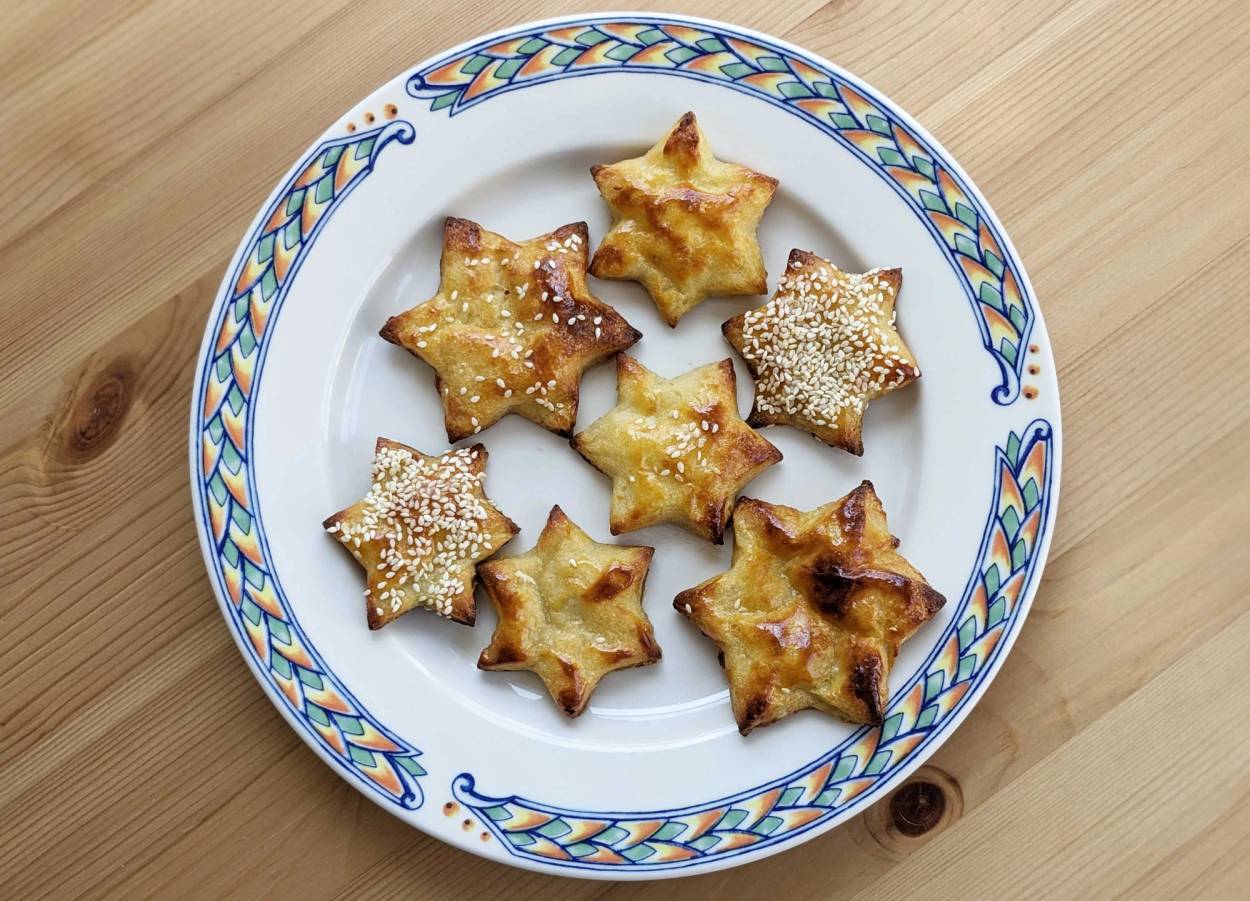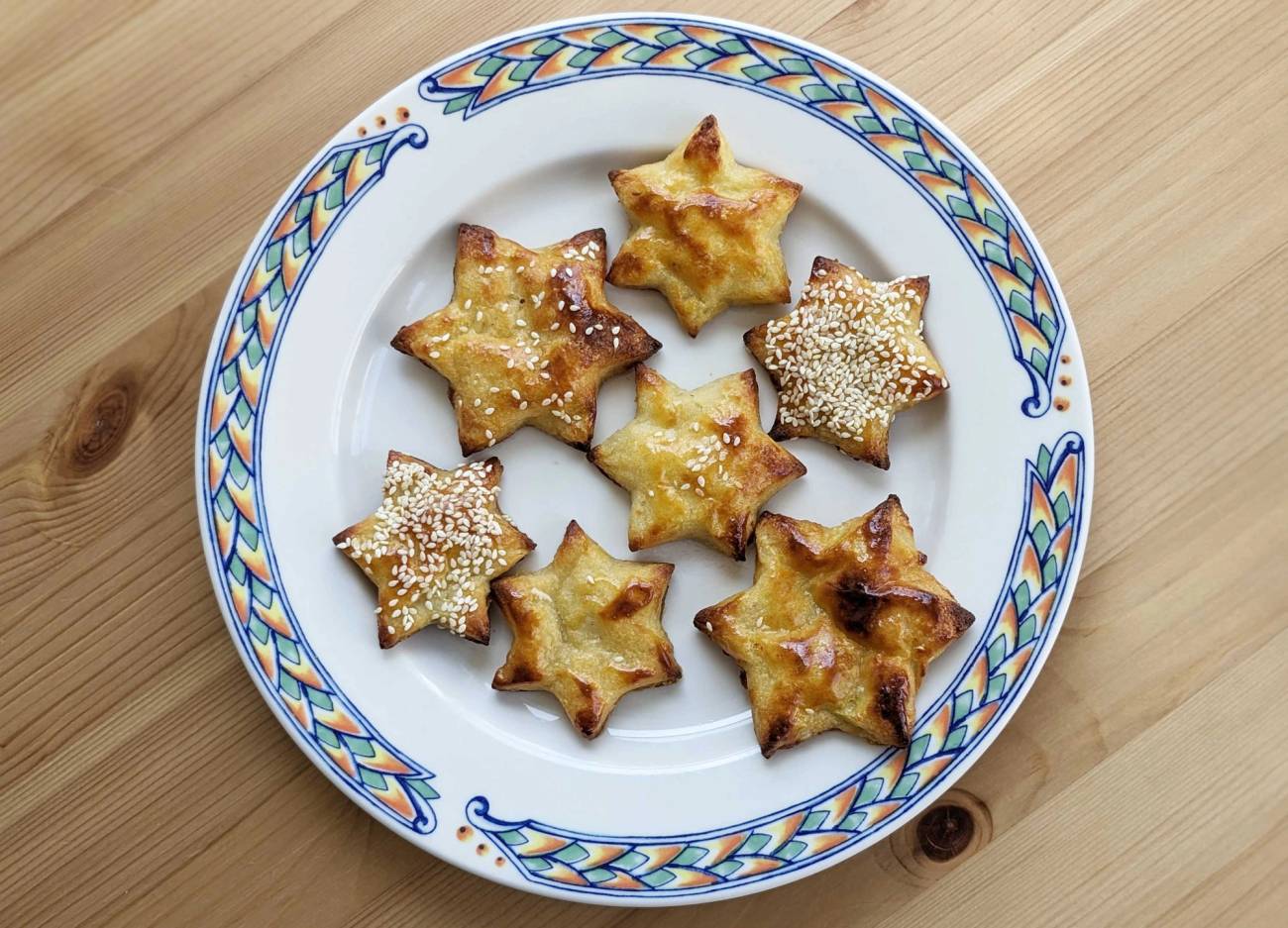The Shape of Pastries Past
Trying to recreate my great-grandmother’s cheese-filled bollos




For most Sephardic families, the story of bollos—a savory, cheese-stuffed pastry from pre-Inquisition Spain—is one of a centuries-old Jewish culinary tradition. In my family, however, bollos tell an even older Jewish story, one dating as far back as the days of pre-antiquity: the battle between a woman and her mother-in-law.
And for me, the story of bollos is a story of vindication.
For nearly 70 years my grandmother tried, and failed, to reproduce the perfectly Star of David-shaped bollos that my grandfather’s mother was known for. My grandmother, a deaf jitterbug-dance champion, loved to upstage those who underestimated her almost as much as she hated having things condescendingly explained to her by people who could hear; she must have seen her mother-in-law’s ostentatiously shaped bollos and set out to replicate them on her own.
And yet, even as a woman whose cooking shimmered with some intangible quality of verve and ingenuity, my grandmother remained stumped by the shape of these pastries for the length of her marriage, and as if she were wrestling with a ghost, my grandmother kept trying even after my great-grandmother, passed away. She tried again and again to produce the perfectly cut points of her mother-in-law’s pastries, but never managed it. My grandmother’s bollos always turned out, in the words of my uncle, “lopsided and deformed.” Some might even have looked at this ordeal and seen in it the premonitions of the lifelong gully between herself and the man who was my grandfather.
Almost a century after it began, I set out to put my grandmother’s endeavor to rest.
My grandmother’s struggles with bollos stemmed from two very different but equally challenging realities. The first is that bollos themselves are a beast of unknown provenance. As I took on this contested family recipe, never having tasted them myself, I found myself asking: What exactly is a bollo? No living person today really seems to agree on the answer, or on a spelling for that matter, since they are also known as boyos, boyoz, and bolos.
The word bollo itself comes from the Spanish bollo, which means bun. The most common type of bollos are filled, savory pastries. Unyeasted dough balls are marinated in olive oil, then rolled out into a circle and filled with mashed potato, feta and parmesan cheese, and sometimes spinach. Then the dough is rolled like a cigar and twisted into a bun in the shape of a snail. These pastries arrived in Turkey after the expulsion of the Jews from Spain in the 15th century, and would remain a staple of Turkish cuisine for the next 600 years.
Bollos are different from boyikos, the diminutive form meaning little boyo, which are not simply smaller versions of bollos, but a thing unto themselves: Boyikos are more like cheese biscuits without a dough. And then there are bourekas—sheets of puff pastry filled with cheese and spinach, and sometimes squash. Different in both appearance and preparation to the typical coiled bollos, the terms bourekas and bollos are, nonetheless, used interchangeably, despite some Sephardic Jews disagreeing with the flattening of these terms. Others will contend that bollos are a form of boureka, while another group holds that it is, in fact, the other way around: A square is a rhombus, but a rhombus is not a square. An odd effect of repeated exiles over the course of centuries is that nobody is sure of anything in the kitchen except that they disagree with everyone else. I do not even have an accurate description of my great-grandmother’s bollos, aside from the shape.
The second problem facing my grandmother was her lifelong imprecision in all things. Everything in her life was done by approximation. Being deaf put up an impenetrable veil between my grandmother and the rhythms of the hearing world, which seemed to spill out into other areas of her life. Instead of fretting, she adapted. Ingredients could be substituted or forgone entirely; volumetric measurements were abstract concepts. The rows of stitches in her knitwear varied wildly, creating scarves of baffling proportions. Even her birthday is itself an approximation: She was born on July 4, 1924, but her father did not submit her birth certificate until July 11, creating a deluge of confusion when dealing with legal paperwork. Life, for my grandmother, was one extended act of improvisation. This meant deftly stitching together otherwise incongruous ingredients into what would become a signature meal, or deciding one day in her 20s to buy a motorcycle even if it wasn’t acceptable for women to ride them in polite Egyptian society; this spirit endured into her late 80s when, without any premeditation, she signed up for yoga classes.
The thought of my grandmother attempting to shape a pastry that, by definition, has a fixed number of points, is itself almost absurd. If the Star of David had some flexibility—if it could be represented with anything between five and seven points—that would be another story. I know this because I inherited her imprecision, and admittedly, the idea of my doing this is no less absurd.
Relying on the collective memories of my father and uncle—the only two people who had tried both my grandmother and my great-grandmother’s bollos—introduced yet another hurdle: Their descriptions of bollos varied wildly from recollection to recollection. Sometimes bollos would sound more like bourekas, then other times like savory hamantaschen, crackers, biscuits, spanakopita, or a thing “with flour, but not too much flour.” I realized quickly that I’d have to traverse this muddied terrain alone, much as my grandmother had.
I first attempted making traditional bollos. I spent nearly half an hour kneading dough to the correct elasticity until my arms were sore. Then I spent the next five consecutive hours trying and failing to calibrate the correct volume of filling so that the rolled pastry could be coiled not in the shape of a snail, but into the shape of a Star of David. Finally, my (not Jewish) partner helped me devise a method of weaving two doughy triangles into one another, forming a semibraided Star of David.
“I’ve never seen anything like this in my entire life,” my father said upon seeing them.
My father put me in touch with a distant cousin in Turkey, who sent me a page of her Sephardic recipe book—not for bollos, but for boyikos. The measurements on the recipe read as if they’d been transcribed by my grandmother herself: a glass of cheese, a glass of oil, some water, and as much flour as the mixture can hold. The difference with boyikos is that instead of wrapping the mixture in dough, the paste is rolled out and then shaped by hand before going straight into the oven. It has no outer layer, and the result is a harder, firmer biscuit.
After trying repeatedly to shape the dough by hand, as was traditional, I folded and ordered a multi pack of Star of David-shaped cookie cutters from Amazon.
The consistency of this batch was closer, but, according to my father, the taste was off. The problem was that no recipe for boyikos seems to include potatoes, and perhaps the only thing my dad and uncle agreed on was that the bollos they knew from childhood had potatoes in them.
My third attempt was a hybrid: What if I combined the technical biscuitlike approach of boyikos, but added boiled potatoes to the mixture, almost like gnocchi.
As the hybrid biscuit sat in the oven, suddenly my apartment was filled with the familiar scent of walking into my grandmother’s apartment on 98th Street. It was a smell that I never even knew I’d cataloged in my mind, and strange as it was to me then, I knew now that what I’d been smelling were bollos.
I had the recipe. Now for the shape.
The difficulty with working with a gnocchilike dough is that it moves almost like a non-Newtonian fluid. It seems to fit nicely into a Star of David cookie cutter mold, but then sticks to the side and needs to be poked out. Standing over my kitchen counter, I felt my grandmother’s decadeslong desperation coursing through me. Poking the dough out of the mold leaves behind it a mushy, Dr. Seussian shape, and any attempts at pinching the stars back into shape only further deform it. Neither butter nor olive oil allowed the mold to release the dough gracefully.
To solve this problem, I turned to yet another solution that did not exist in 1950s Egypt, and which my Ottoman great-grandmother would never have used: a copious amount of nonstick cooking spray applied directly to the side of the cookie cutters.
The result was six, golden brown Stars of David the size of my palm. Neither bollos nor boyikos, really, they might perhaps be best described as a thing of their own—boyikones, or big little bollos.
I do not know what exactly my great-grandmother’s trick was. In all likelihood, the knack for bollos probably came from a kind of patience that neither my grandmother nor I seemed to have; star-shaped bollos seem almost like a recipe designed to clash against our shared foibles, and so naturally I had to find some other path toward it. To some, nonstick spray might even count as cheating, but my grandmother’s entire life had been composed of stratagems to outwit and outmaneuver her own weaknesses; if Pam had been available to her in Egypt, she would have used it, thrilled to have found a way of imposing her will onto this recipe, and more importantly, onto a mother-in law who did not think a deaf woman was good enough for her hearing son. But bollos remained one of her lone culinary blunders. And this year, on both of my grandmothers’ birthdays, I’ll bake the elusively shaped bollos in remembrance and to let her know we’ve finally vanquished them.
Alexander Aciman is a writer living in New York. His work has appeared in, among other publications, The New York Times, Vox, The Wall Street Journal, and The New Republic.